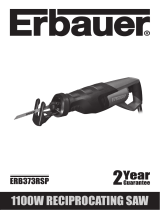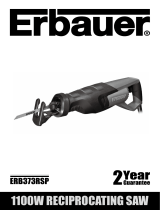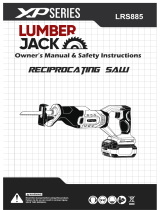Page is loading ...

RD3654
RECIPROCATING SAW EN


RD3654
1
2 3
4
6
5
8
7

RD3654
8
1
3
A B C
D E1 E2
F1 F2

5
RECIPROCATING SAW EN
COMPONENT LIST
ACCESSORIES
Blade for wood 1
Hex key 1
We recommend that you purchase your accessories
from the same store that sold you the tool. Refer to
the accessory packaging for further details. Store
personnel can assist you and offer advice.
GENERAL POWER TOOL SAFETY
WARNINGS
WARNING! Read all safety warnings,
instructions, illustrations and specications
provided with this power tool. Failure to follow all
instructions listed below may result in electric shock,
re and/or serious injury.
Save all warnings and instructions for future
reference.
The term “power tool” in the warnings refers to
your mains-operated (corded) power tool or battery-
operated (cordless) power tool.
1) Work area safety
a) Keep work area clean and well lit. Cluttered or
dark areas invite accidents.
b) Do not operate power tools in explosive
atmospheres, such as in the presence of
ammable liquids, gases or dust. Power tools
create sparks which may ignite the dust or fumes.
c) Keep children and bystanders away while
operating a power tool. Distractions can cause
you to lose control.
2) Electrical safety
a) Power tool plugs must match the outlet. Never
modify the plug in any way. Do not use any
adapter plugs with earthed (grounded) power
tools. Unmodied plugs and matching outlets will
reduce risk of electric shock.
b) Avoid body contact with earthed or grounded
surfaces, such as pipes, radiators, ranges and
refrigerators. There is an increased risk of electric
shock if your body is earthed or grounded.
c) Do not expose power tools to rain or wet
conditions. Water entering a power tool will
increase the risk of electric shock.
d) Do not abuse the cord. Never use the cord for
carrying, pulling or unplugging the power tool.
Keep cord away from heat, oil, sharp edges
or moving parts. Damaged or entangled cords
increase the risk of electric shock.
e) When operating a power tool outdoors, use an
extension cord suitable for outdoor use. Use of
a cord suitable for outdoor use reduces the risk of
1
Blade
2
Pivoting foot plate
3
Blade holder
4
On/Off switch
5
Lock on button
6
Main handle
7
Guide plate adjustment
8
Hex key
Not all the accessories illustrated or described are included in standard delivery.

6
RECIPROCATING SAW EN
electric shock.
f) If operating a power tool in a damp location is
unavoidable, use a residual current device (RCD)
protected supply. Use of an RCD reduces the risk
of electric shock.
3) Personal safety
a) Stay alert, watch what you are doing and use
common sense when operating a power tool. Do
not use a power tool while you are tired or under
the inuence of drugs, alcohol or medication. A
moment of inattention while operating power tools
may result in serious personal injury.
b) Use personal protective equipment. Always
wear eye protection. Protective equipment such
as dust mask, non-skid safety shoes, hard hat, or
hearing protection used for appropriate conditions
will reduce personal injuries.
c) Prevent unintentional starting. Ensure the
switch is in the off-position before connecting to
power source and/or battery pack, picking up or
carrying the tool. Carrying power tools with your
nger on the switch or energising power tools that
have the switch on invites accidents.
d) Remove any adjusting key or wrench before
turning the power tool on. A wrench or a key left
attached to a rotating part of the power tool may
result in personal injury.
e) Do not overreach. Keep proper footing and
balance at all times. This enables better control
of the power tool in unexpected situations.
f) Dress properly. Do not wear loose clothing or
jewellery. Keep your hair and clothing away from
moving parts. Loose clothes, jewellery or long
hair can be caught in moving parts.
g) If devices are provided for the connection of
dust extraction and collection facilities, ensure
these are connected and properly used. Use of
dust collection can reduce dust-related hazards.
h) Do not let familiarity gained from frequent use
of tools allow you to become complacent and
ignore tool safety principles. A careless action
can cause severe injury within a fraction of a
second.
4) Power tool use and care
a) Do not force the power tool. Use the correct
power tool for your application. The correct
power tool will do the job better and safer at the
rate for which it was designed.
b) Do not use the power tool if the switch does not
turn it on and off. Any power tool that cannot be
controlled with the switch is dangerous and must
be repaired.
c) Disconnect the plug from the power source and/
or remove the battery pack, if detachable, from
the power tool before making any adjustments,
changing accessories, or storing power tools.
Such preventive safety measures reduce the risk
of starting the power tool accidentally.
d) Store idle power tools out of the reach of
children and do not allow persons unfamiliar
with the power tool or these instructions
to operate the power tool. Power tools are
dangerous in the hands of untrained users.
e) Maintain power tools and accessories. Check
for misalignment or binding of moving parts,
breakage of parts and any other condition
that may affect the power tool’s operation. If
damaged, have the power tool repaired before
use. Many accidents are caused by poorly
maintained power tools.
f) Keep cutting tools sharp and clean. Properly
maintained cutting tools with sharp cutting edges
are less likely to bind and are easier to control.
g) Use the power tool, accessories and tool bits
etc. in accordance with these instructions,
taking into account the working conditions and
the work to be performed. Use of the power tool
for operations different from those intended could
result in a hazardous situation.
h) Keep handles and grasping surfaces dry, clean
and free from oil and grease. Slippery handles
and grasping surfaces do not allow for safe
handling and control of the tool in unexpected
situations.
5) Service
a) Have your power tool serviced by a qualied
repair person using only identical replacement
parts. This will ensure that the safety of the power
tool is maintained.
RECIPROCATING SAW SAFETY
WARNINGS
1. Hold reciprocating saw by insulated gripping
surfaces, when performing an operation where
the cutting accessory may contact hidden

7
RECIPROCATING SAW EN
wiring or its own cord. Cutting accessory
contacting a “live” wire may make exposed metal
parts of the power tool “live” and could give the
operator an electric shock.
2. Use clamps or another practical way to secure
and support the workpiece to a stable platform.
Holding the workpiece by hand or against your
body leaves it unstable and may lead to loss of
control.
3. Recommendation that the tool always be
supplied via a residual current device with a
rated residual current of 30 mA or less.
SYMBOLS
To reduce the risk of injury, user
must read instruction manual
Wear ear protection
Wear eye protection
Wear dust mask
Double insulation
Warning
RCM marking
ABN:
Australian Business Number. By this number, business
information such as entity type, status, business location etc.
can be found at website http://abr.business.gov.au.
ABN of Positec Australia
Pty Ltd
is 14 101 682 357
TECHNICAL DATA
Rated Voltage 220V-240V~ 50Hz
Rated Power 800W
Rated No-load speed 0-2700 /min
Stroke length 20mm
Cutting capacity max.
Wood 115mm
Steel 10mm
Plastic 15mm
Protection class
/II
Machine weight 2.3Kg
OPERATING INSTRUCTIONS
NOTE:
Before using the tool, read the instruction
book carefully.
Intended Use
The machine is intended for sawing wood, plastic,
metal and building materials while resting rmly on the
workpiece. It is suitable for straight and curved cuts.
ASSEMBLY
Replacing / Inserting the saw blade (See Fig. A)
Warning: Remove the plug from the power
source before carrying out any adjustment,
servicing or maintenance.
When mounting the saw blade, wear protective
gloves. Danger of injury when touching the saw blade.
When changing the saw blade, take care that the saw
blade holder is free of material residue, e. g. wood or
metal shavings.
1. Selecting a Saw Blade
Use only saw blades with single-nose shank. The
saw blade should not be longer than required for the
intended cut. Use a thin saw blade for narrow curve
cuts.
2. Inserting a Saw Blade
Rotate the blade holder (3) anti-clockwise and hold it
in position. Insert the blade into the saw’s blade clamp
and make sure that the blade attaches to the blade pin
inside the clamp. Release the blade clamp ring and

8
RECIPROCATING SAW EN
ensure the blade is locked securely in place.
Warning: Check the tight seating of the saw
blade. A loose saw blade can fall out and lead
to injuries.
For certain work, the saw blade (1) can also be turned
through 180° (with the teeth pointed upwards) and
reinserted again.
3. Removing a Saw Blade
Rotate the blade holder (3) anti-clockwise and hold. Pull
the blade out and release the clamp ring.
OPERATION
1. Pivoting foot plate adjustment (SEE FIG. B)
Due to its movability, the adjustable pivoting foot
plate (2) adapts to the required angular position of
the surface. It must be held rmly against the material
being cut to reduce saw vibration, blade jumping and
blade breakage.
If you need to reduce the cutting capacity of your
tool (depth of cut), the pivoting foot plate (2) may be
adjusted as follows. Loosen the two securing screws
(a) on the underside of the front housing with a hex
key (8). Slide the pivoting foot plate (2) to the required
position. Tighten both screws (a) and check that the
pivoting foot plate (2) is rmly latched.
2. Switching on and off (SEE FIG. C)
Depress the On/Off switch (4) to start and release it
to stop your tool. Depress the on/off switch (4) then
the lock on button (5). Your tool is now locked on for
continuous use. To switch off your tool just depress
and release the on/off switch (4).
3. Variable speed control (SEE FIG. D)
The On/Off switch (4) is also a variable speed controlled
trigger switch. The blade plunger stroke rate can
be adjusted from the minimum to maximum by the
pressure you apply to the On/Off switch. Apply more
pressure to increase the speed and release pressure to
decrease speed.
4. Cutting instruction plunge cutting (SEE FIG. E1, E2)
The plunge cutting procedure is only
suitable for treating soft materials such as
wood, plaster board or similar! Do not work metal
materials with the plunge cutting procedure!
Use only short saw blades for plunge cutting.
Place the machine with the edge of the pivoting foot
plate (2) onto the workpiece and switch on. For power
tools with stroke speed control, set the maximum
stroke speed. Press the power tool rmly against the
workpiece and allow the saw blade to slowly plunge
into the workpiece.
As soon as the pivoting foot plate (2) fully lays on the
surface of the workpiece, continue sawing alongside
the desired cutting line. For certain work, the saw blade
(1) can also be inserted turned through by 180° and
the sabre saw can be guided accordingly in a reversed
manner.
Flush cutting (SEE FIG. F1, F2)
Pay attention that the saw blade always
extends beyond the diameter of the material
being worked. There is danger of kickback.
It is possible to make cuts extremely close to oors,
walls and other difcult areas. Insert the blade shank
into the blade clamp with the blade teeth facing up
(opposite to normal working position). This will make
cuts closer to the work surface. Using special exible
blades insert the blade into the blade clamp with the
blade teeth facing down (normal working position). It
will allow ush pipe cutting.
Wood cutting
For easier control use low speed to start cutting, then
increase to the correct speed.
Metal cutting
This saw has different metal cutting capacities
depending upon the type of blade being used and metal
being cut.
Use a ner blade for ferrous metals and a coarse blade
for non-ferrous metals.
When cutting thin gauge sheet metals, ALWAYS clamp
wood on both sides of the sheet. This will give you a
clean cut without excess vibration or tearing of the
metal.
DO NOT force the cutting blade. Forcing the blade will
reduce blade life and cause the blade to break.
NOTE: We recommend that you spread a thin lm of oil
or other coolant along the line of cut ahead of the saw.
This will allow easier operation and help extend blade
life. When cutting aluminum, use kerosene.

9
RECIPROCATING SAW EN
WORK HINTS FOR YOUR
RECIPROCATING SAW
If your power tool becomes too hot, set the speed to
maximum and run a no load for 2-3 minutes to cool the
motor.
Always ensure the work-piece is rmly held or clamped
to prevent movement.
The blade guard must be held rmly against the
material being cut to reduce saw vibration, blade
jumping and blade breakage.
MAINTENANCE
Remove the plug from the socket before carrying out
any adjustment, servicing or maintenance.
There are no user serviceable parts in your power
tool. Never use water or chemical cleaners to clean
your power tool. Wipe clean with a dry cloth. Always
store your power tool in a dry place. Keep the motor
ventilation slots clean. Keep all working controls free
of dust. Occasionally you may see sparks through the
ventilation slots. This is normal and will not damage
your power tool.
If the supply cord is damaged, it must be replaced by
the manufacturer, its service agent or similarly qualied
persons in order to avoid a hazard.



POSITEC AUSTRALIA PTY LTD
ABN 14 101 682 357
MADE IN PRC
Copyright © 2018, Positec. All Rights Reserved.
/


